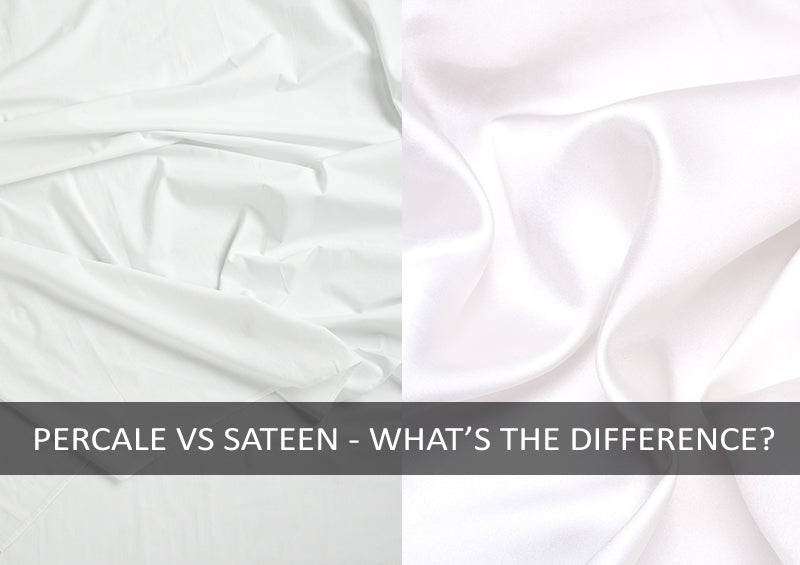The main differences to note between cotton percale and cotton sateen are:
- Structure – percale has a much tighter weave.
- Strength – percale is a stronger fabric that is harder to snag or tear.
- Finish – percale has a matte finish, whereas sateen is silky and shiny.
Keep reading to find a more in-depth explanation of the differences between percale vs cotton and which you should be purchasing for your home.
Percale vs Sateen – How do they differ?
The biggest difference between cotton percale and cotton sateen is the weave structure.
There are two types of threads that go into a fabric; warp and weft.

The weft threads in percale weave one under, one over and repeat this consistently throughout the fabric.
The weft threads in sateen weave one under and then several over. Most manufacturers stick to four, although this can vary.
The length of thread that is exposed on the surface of the fabric is ‘floating’. The lack of interlacing and weaving creates a smooth, flat surface which gives a shiny appearance.
As percale has regular interlacing, this creates a matte appearance.
But, does this difference in structure affect the quality?
In some ways, yes.
Many favour sateen for the soft and silky feel, as the weave structure isn’t as tight or rigid. But the downside is that this structure is slightly weaker and less resilient to wear and tear.
The exposed threads are more vulnerable, which can cause snagging.
Percale is a much stronger and tougher fabric that has a crisper feel to it. If you are looking for a comparison, it feels similar to cotton sheets you may have at home.
What is a sateen finish?
The finish is soft, shiny and silky. The ‘floating’ longer lengths of thread are what give this fabric its shiny appearance.
As percale is consistently woven in and out in and out, it has a tight weave that gives a matte appearance.
Although the long exposure of threads gives sateen a luxurious and soft finish, this does make it more susceptible to snagging and tearing.
Is sateen the same as satin?
Although they may have a similar appearance, the texture and strength differs due to the contrast in materials. Sateen is usually made from cotton, whereas satin can be made from silk, nylon or polyester.
Although cotton can be treated and manufactured to give a satin-like appearance, sateen is not quite as shiny and silky as satin and its finish has more of a sheen.
The two materials are similar in strength and durability, so it’s down to whether you prefer the luxurious look of satin or slightly more relaxed feel of sateen.
How are sateen sheets made?
Sateen sheets are manufactured on a loom similar to most woven fabrics. The loom holds the warp threads tightly in place whilst the weft threads are weaved through.
You can see a loom in action here:
The bed sheets are made by interlacing the thread over, skipping a few or several warps and then being woven back under to create a long exposure of the thread.
Which is cooler – sateen or percale?
Percale is a much cooler fabric than sateen and is perfect for hot climates. Sateen is warmer and is ideal for cooler climates.
Percale sheets are famous for their ultra-crisp and cool feel against the skin, which is why they’re a favourite for so many.
Sateen sheets create a more luxurious sleeping environment. Many prefer this fabric for the silky-smooth finish and find this a more comfortable option. They also create a warm and cosy environment, which is why we recommend this fabric for Winter.
Which is softer – sateen or percale?
It is difficult to measure softness as it is more of a personal preference.
Neither one is softer than the other, they are just different types of soft. Percale is a classic cotton softness that many of us are familiar with. It becomes softer over time with usage and washing.
Sateen has a silky softness, which has a smoother feel. This is preferred by many as it is seen to be more luxurious.
Of course, the quality of fabric plays a huge role in the softness, which is why we’d recommend purchasing 100% cotton.
Where can I buy sateen bed sheets?
When purchasing high quality sheets such as sateen, it is always a good idea to be wary of fakes and cheap, poor quality fabrics.
Avoid products that don’t state what materials have been used for the fabric. We would also recommend using a reliable bedding supplier that specialises in the industry to get the best quality for your home or establishment.
At Hafco we firmly believe in the importance of good sleep, which is why we provide high quality products at an affordable price.
 Free Shipping
Free Shipping
 +44(0)1204 529156
+44(0)1204 529156
 m.ahmad@swliving.co.uk
m.ahmad@swliving.co.uk

